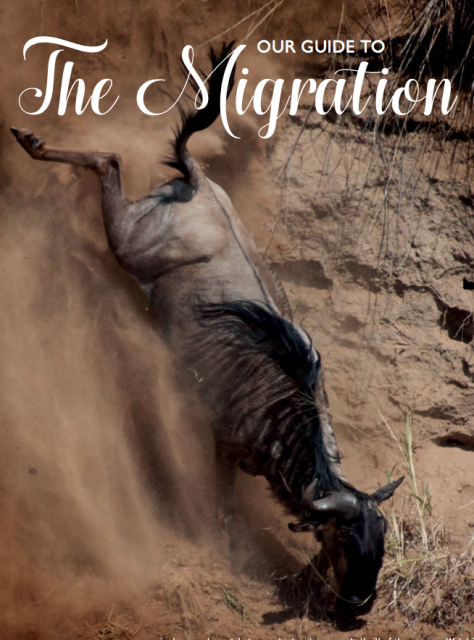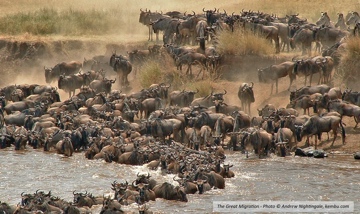Animals that Migrate
The annual great migration is now coursing across the Maasai Mara. Here I have a look at which animals migrate, and why they do so.

The Great Migration is an annual cycle in which vast numbers of animals flow in a circuit around Kenya and Tanzania. While it’s generally accepted that the animals move because of the rains and the resulting sprouting of fresh grass, there are many aspects of the migration that are still not fully understood. Why, for example, do the animals continue to move in a year when rainfall is plentiful, and food is as abundant in the area they’re leaving as it is in the area to which they’re going? Some say their instinct to migrate is too deep to resist. Others suggest the animals are attracted to high levels of phosphorus and nitrogen in specific grasses. Still more claim they’re steering clear of soggy woodlands, either to escape foot disease or to avoid tall grasses where predators hide.
Wildebeest
The most numerous animal to migrate is the wildebeest, also known as the gnu. Around 1.5 million wildebeest migrate, turning the golden savannah plains black with their sheer volume.
A genus of antelopes, wildebeest fall into the category of even-toed horned ungulates, a species that includes antelopes, cattle, goats and sheep. Wildebeest fossils dating back two and a half million years have been found, confirming that these animals were widespread in prehistoric times. Standing up to a height of one and a half meters, and weighing about 250kg, wildebeest are one of the larger antelopes. They have developed what’s known as ‘swarm intelligence’, where they herd together as a defensive system and act as one. They also pick up the alarm calls of other species such as zebra and baboon, in order to protect themselves. Wildebeest breed seasonally, and their foals are born between January and March. A new-born wildebeest can stand within three minutes of being born, and can run with the herd within five minutes. The wildebeest, with its long narrow face and curved horns, was used as the model for the Beast in Walt Disney’s animated film, Beauty and the Beast.
Zebra
About 200,000 zebras migrate, and they often integrate into the herds of wildebeest, the two species giving each other protection and sharing alarm calls.
Zebras are closely related to horses and donkeys but, unlike these, have never been domesticated. They stand up to one and a half meters tall, and weigh up to 350kg. There are three species of zebras: plains zebra – also known as Burchell’s zebra –, mountain zebra and Grevy’s zebra
Possibly the most distinctive thing about the zebra is its stripy coat. The stripes are unique to each animal, just as a human’s fingerprints are. Many theories exist to define why zebras have stripes, ranging from camouflage, to insect deterrent, to sunscreen.
Thomson’s Gazelle
Named after the explorer Joseph Thomson who led several expeditions across Africa in the late 19thcentury, these gazelles are the most common type of gazelle in Africa. They migrate in numbers of up to 350,000. With a distinctive black stripe along each side, and a dainty bouncing gait, the Thomson gazelle is considered one of the most attractive plains animals. However, being one of the smallest, they are at risk not only from large cats, but from eagles, jackals, baboons, crocodiles and pythons.
Thomson’s gazelles are unusual in that they both browse and graze. The males are territorial, and clashes between them at the boundaries of their territories, or over a nearby female, are common. The Thomson’s gazelle was part of a gag in Monty Python’s Flying Circus.
Eland
Around 12,000 elands also migrate along with the herds of wildebeests, zebras and Thomson’s gazelles. These, the largest of the antelopes, can be over one and a half meters tall, and weigh up to 940kg, although the average weight is around 600kg. It’s said that elands can jump up to two meters from standing.
Both males and females have spiral horns; the males use them for fighting while the females use them more for protecting their young. The slowest antelope, these animals can run up to 40km per hour for a brief sprint, or trot at 22km per hour. They make a loud clicking sound when moving, which might be caused by their weight making their hooves splay apart, or a way of communicating.
Tamara Britten, 19 August 2020
Published also in: The Link: Safarilink's inflight magazine
About the region
Maasai Mara

Famous around the world for its exceptional, abundant wildlife, the Maasai Mara National Reserve has become known as the Seventh Wonder of the World. Not only are all the members of safari’s Big Five found here, but over 100 other mammal species and over 450 bird species live within the reserve.
Read more about Maasai Mara